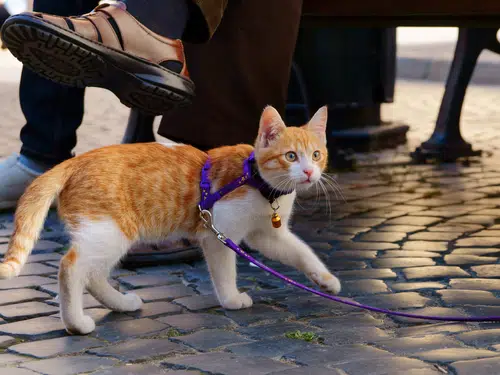Home » Blog » Pet » Pet Parenting Lifestyle » How to Train Your Cat to Walk on a Leash
Categories
Tags
animal welfare
breed profile
buying a car
buying a pet
Car
car accessories
car care
car features
car insurance
Car safety
car sales
car service
cat
cat behaviour
cat body language
Cat Breeds
cat food
cat insurance
comprehensive car insurance
Dog
Dog Behaviour
dog body language
Dog Breeds
dog food
Dog Insurance
dog training
eco friendly cars
Kitten
New Car
pet accessories
pet activities
Pet Adoption
pet breeders
pet days of the year
pet fun stuff
Pet Health
pet insurance
pet parenting
Pet Safety
pet services
Puppy
rescue pets
road safety
road trip
safe driving
Recent Blog:
Facebook Posts
13 hours ago
Are intestinal worms setting up camp in your dog’s gut without paying rent? Here’s how to spot the main culprits and get rid of them too:![]()
![]() Preventing, Identifying and Treating Intestinal Worms in Dogs - bit.ly/43YjCKu
... See MoreSee Less
Preventing, Identifying and Treating Intestinal Worms in Dogs - bit.ly/43YjCKu
... See MoreSee Less
Preventing, Identifying and Treating Intestinal Worms in Dogs
www.pd.com.au
Intestinal worms, such as roundworms in dogs are one of the least glamorous topics on the planet. These intestinal parasites that basically use our dogs
PD Insurance
with Dogs West.
2 days ago
We enjoyed meeting #breeders #doglovers and members at the Dogs West Open Day. Special thanks to our partner Dogs West for organising an incredible event. There is still time to enter our pawsome competition. Click here for details: bit.ly/4covyce![]() #PDinsurance #dogswestopenday #dogswest
... See MoreSee Less
#PDinsurance #dogswestopenday #dogswest
... See MoreSee Less
3 days ago
Did you know? The Manx is a breed that is known for its lack of a tail, which is caused by a genetic mutation.
... See MoreSee Less
Training your cat to walk on a leash isn’t something all cat owners do. But it can be a fun way to spend quality time together, especially with an indoor cat.
But unlike dogs, cats don’t always take to walking on a leash or harness that naturally. Some cats simply don’t like it, and while perseverance is often key when it comes to animals, it might not be their thing.
Training your cat to walk on a leash is more like a suggestion, truth be told. We all know cats are strong-willed. So if they refuse to walk on the leash or harness, it might be futile trying to change their minds. That said, some take to walking like ducks to water.
And if it’s an activity your kitty enjoys, it’s up to you to make regular walks happen.
6 steps to training your cat to walk on a leash
Although most of us think of cats as highly independent, they usually like “we time” as much as “me time.” And what better way to get in some we time than with a walk?
Follow this six-step process to get your cat practically pulling on their shoes and socks for a walk:
- Assess. Is your cat likely to love or hate the idea of walking?
- Shop. Treat kitty to a leash and harness, or borrow them.
- Harness train. Get your cat accustomed to the harness.
- Leash train. Harness training done, now it’s time to add the leash.
- Walk indoors. One step at a time.
- Walk outdoors. You (and your cat) are ready to take on the world!
It’s important to adequately prepare your cat for walking outside on a leash. Which means patience and time. If you rush it or add a lot of pressure, your cat might get scared. Here’s what that could look like:
1. Assess if your cat wants to be trained to walk on a leash
Like humans, some cats are more adventurous than others. Does your cat show interest in going outside? Do they scratch the door or perch at the window? Do they follow you if you go into the garden to catch some sun?
Follow your gut instinct on this one, and take the lead from your cat. Usually, pet parents will have a good idea of their cat’s likes and dislikes.
Also, read up on friendliest cat breeds – it gives you some hints as to which cats are more inclined towards walking on a leash.
Go shopping
Aaah, the fun part. Some retail therapy is always welcome.
When you’re training your cat to walk on a leash, you’ll need a cat harness plus a lead. And no, you can’t just cut go straight for the leash and a cat collar. A harness is crucial.
Why? Cat collars aren’t secure enough. Read all about breakaway cat collars. Though they’re safe for general use, you can’t use them with a lead on a walk. And regular, non-breakaway cat collars are no safer.
Basically, your cat is likely to get away if you just use a collar. And if they bolt, they might get hurt or lost. So if you want to walk with your cat, safety should be top of mind. Get the harness! Read this article about the best cat harnesses for more information.
3. Familiarising your cat with the harness
Before you start walking, take some time to get your cat used to the harness. Gently slip it on, then let your cat walk around for a bit to get used to the feeling of it. Some praise, strokes, and treats never harmed at this stage either.
This is a simple way for your cat to experience the harness in a safe environment. Using positive reinforcement training by using treats and praise when your cat wears the harness helps them to associate it with positive things too.
Remember to supervise your cat when they wear the harness. You don’t want it getting caught while you’re looking in the other direction.
4. Getting used to the leash
If your cat’s happy and comfortable with the harness, we can now move onto the next step. When you’re training your cat to walk on a leash, they obviously have to accept the leash itself.
It’s an easy process – just clip the leash onto the harness and let them get used to it. Exactly the same way you did with the harness. Again: treats, praise, scratches and general positivity are all your best friends here.
Let your cat dictate the pace. If they love their harness and leash from the get go it might only take a couple of days. If they’re unsure, maybe a few weeks.
5. Training your cat to walk on a leash indoors
Now that everyone’s comfortable with their walking accessories, the actual walking begins. We like to think it’s similar to how a great pair of running shoes or leggings make you more motivated to actually go and run.
Start off by taking your cat on short walks around the house. A good way to encourage your cat is to use treats to make a little trail. That way, your cat should sniff them out and you can walk with the lead in hand so they start to understand the process.
Otherwise, they might get confused. It’s not uncommon for cats to simply lie down and stare at you, leaving the eager beaver humans with useless lead in hand as they lounge around.

6. Training your cat to walk on a leash outdoors
Assuming everything has gone well so far, you’re now ready to start walking your cat on a leash outdoors. Woohoo for new adventures! Remember to bring along treats for back up.
A few other things to keep in mind when you start training your cat to walk on a lead outdoors:
- Stick to quiet spaces and avoid dogs.
- Let your cat take the lead for the first few walks. So they’re walking you, rather than the other way round.
- After a few walks, start letting your cat be the follower. When you choose a direction to walk in, simply apply gentle tension on the leash to lead the way.
Your walks might be short, bringing you back home in 10 minutes. Or you might have an adventurous cat who wants to explore every nook and cranny along the way.
Take time and trust when training your cat to walk on a leash
Getting it right can take some time. The main thing is to be open minded and flexible. What works for one cat might not work for the next. Trust your pet parent sixth senses and go with what feels right for your cat.
Cat insurance for a soft landing
Luckily, it’s not the cat who makes the decisions when it comes to pet insurance. Have a look at our three cat insurance plans. They give you a wide range of options for every kind of cat, with cover ranging from just accidents to all the frills, bells, and whistles you could imagine.
Share On:




